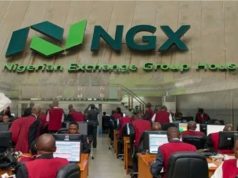…Interesting new data on the literacy/industrialisation theme
By Charles Ike-Okoh
TUE, JANUARY 30 2018-theG&BJournal- Analysts at the Investment banking firm, Renaissance Capital (RenCap) upgraded its forecast of Nigeria’s GDP growth for the current year to 3% because of what they see as a more accommodating policy stance, a stronger external sector and more balanced growth due to consumer recovery.

RenCap’s Africa economist, Yvonne Mango had forecast a 2% growth but bolstering her current enthusiasm are expectations that the market will do well on the back of the oil price tail-wind.
“We have been recommending investors put money into Nigeria since May (just after our annual Lagos conference and the opening of the FX window). We went “overweight” on Nigerian equities in November – knowing that most investors were still underweight – and that the market could do well. It has. We were lucky to have the oil price tail-wind,” Charlie Robertson, RenCap’s Global Chief Economist wrote in a note to theG&Bjournal, to underscore the enthusiasm.

FX adjustments in the past year to reflect lower commodity prices means that the Naira is now cheap, according to Mango. She reckons the currency is 12% undervalued given the real effective exchange rate model used by RenCap.
” We think a stronger external sector implies FX stability in the short term, so we revise our YE18 forecast to NGN360/$1, vs NGN373/$1 previously. This supports softer inflation of 11-12% in 2018,” Robertson added. He also is banking on improving fiscal oil revenue to complement ongoing efforts to mobilise non-oil fiscal revenue.
Meanwhile, the investment banking firm did what it called ”cross-checking” of Nigeria’s literacy data, “which we think are crucial because in our view, it explains why the commodity crash was so much less painful than it was in the 1980s,” according to Robertson.
The checks revealed a quite different picture for some northern states than they had before and an even better picture for some (mainly) central and southern states.
We did a map, Robertson explains, (originally from Yvonne Mhango’s excellent 37 shades of Nigeria piece) showing literacy rates vs population size in Nigeria on literacy and industrialization. We pointed out that industrialization was more likely in states with a literacy rate of 70% or more, and most likely in states with a literacy rate of 80% or more.
“It may be no coincidence then that the Ministry of Industry, Trade and Investment has chosen Abia (one of the highest literacy rates in the country) and nearby Akwa Ibom (literacy rate of 70-80%) as the first two model zones for its special industrial parks. Other brownfield zones include highly literate Lagos (over 80%), as well as Cross River and Kano (literacy rates of 70-80%).”
A few questions on some of the state level data were raised, and included a footnote for the one state where the data really did not seem likely “We do not mention Zamfara, as the literacy rate contrasts so significantly with the very low secondary school enrollment rate for 2007 published by the NBS”
Again, while cross-checking a recent National Malaria survey conducted by the Nigerian Bureau of Statistics (NBS),a survey that include questions on literacy rates and interviews of roughly 100-200 adult women in each state, they found that in many states, the figures for female literacy were very similar to the 2010 survey cited in the map above. In some states, literacy rates were higher in the 2015 malaria survey, by as much as 10-20 percentage points, vs the 2010 survey.
“Partly this can be explained because literacy is probably rising by 1pp a year, and partly because only 15-49 year old women were interviewed in the malaria survey, and they should have a higher literacy rate than a survey of 15-65+ year old women. In addition, as the 2015 malaria survey sample size is smaller, some differences should be expected,” Robertson said.
“But we find huge differences in the data for some states. Reported literacy is far below what was reported in the 2010 survey, in the far north. Zamfara’s adult female literacy rate was 8% in the 2015 malaria survey, vs the 76% rate cited in the 2010 literacy survey. Sokoto’s was 9% not 67%, and Jigawa’s was 7% vs the 62.5% cited in 2010. If the malaria survey is the more accurate, then it is not possible that Zamfara has an adult (male + female) literacy rate of 82.5% as the 2010 survey suggested. It is far more likely to have an adult literacy rate of 40-60% like Yobe or Katsina. Indeed, when I tweeted about this last year, a lot of replies were from people skeptical about the data in some of those states,” he added.
“The head of the Nigerian Bureau of Statistics pointed out on twitter yesterday that the two surveys are different – with different samples sizes and different original purposes. We cannot prove there were flaws in the 2010 literacy survey that was done before the current head of the NBS was in post. Why bother mentioning this? To show we are geeky about our data – RenCap knows that data is not always reliable, and we like to cross-check what we can, when we can. Second, to re-emphasise our original point that the literacy data does suggest some states in Nigeria, and particularly those in the south, now have the human capital to industrialise. Now Nigeria “just” needs some improvement on electricity and infrastructure.”









